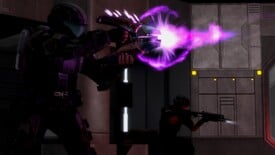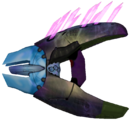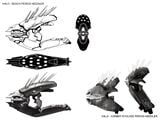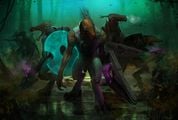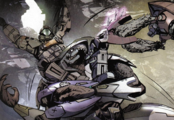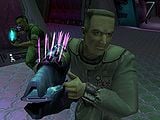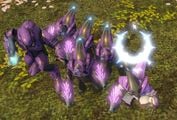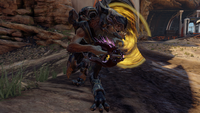Needler
From Halopedia, the Halo wiki
| Needler | |
|---|---|
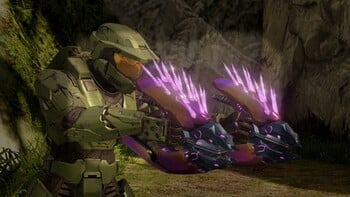
| |
| Weapon information | |
|
Type: |
|
|
Series: |
Needler[1] |
|
Description: |
|
| Production information | |
|
Manufacturer: |
|
|
Model(s): |
|
- "Luckily—listen to me "luckily"—the needles only detonate when they’re embedded in living tissue. Now that’s lucky because it’s not gonna blow a hole in the wall you’re hiding behind or tear the tires off of the vehicle you’re trying to escape in."
- — Anonymous UNSC E2-BAG/1/7 serviceman[6]
Needlers, sometimes known as Needler pistols,[7] are a class of single-handed, fully-automatic infantry specialized weapons developed by the Covenant that launch kemuksuru—also known as Subanese crystalline shards—that are capable of homing in on targets.[1][2] The Covenant and its remnants formally designated the needler as needle launcher or shard launcher,[3][4] while the United Nations Space Command's Office of Naval Intelligence has typically type-classified encountered needlers variants under the designations of Type-33 Guided Munitions Launcher (T-33 GML) or Type-56 Guided Munitions Launcher (T-56 GML).[1][5] Nicknames for the needler include Pinkies and Shrimp Shooter.[8][9]
Overview[edit]
Design details[edit]
- "Anything stuck with enough needles will blow sky high—and if a Foxtrot is unlucky enough to be carrying grenades, those are gonna cook off too."
- — Anonymous UNSC E2-BAG/1/7 serviceman[6]
While there are multiple known patterns of the needler, all patterns share the same general design, which revolves around the needler’s function to fire individual crystalline shards.[1] The top of the weapon contains the needler's distinctive ammunition, Subanese crystals, with the exposed needles protruding from holes in the upper cowling of the weapon chassis. The bottom of the weapon, which contains the power supply, doubles as a stock,[2] with an extended handguard on some design patterns.[1] The two main components converge at the muzzle in front of the grip. The muzzle is situated between an upper and a lower channel brace; the channel braces extend outwards around the muzzle, presumably to prevent the muzzle from being blocked.[2]
Ammunition[edit]
- Main article: Kemuksuru
- "I caught three in the leg as I was diving behind a broken wall—they lodged right in there where the greave meets the boot. When they went off, it damn near broke my ankle and flung like little splinters of glass or crystal or whatever all up my left side—the corpsman was pulling [the shards] outta me for the better part of two hours."
- — Anonymous UNSC E2-BAG/1/7 serviceman[6]
The needler fires shards of kemuksuru[10]—colloquially known as blamite or Subanese crystal—a pink crystalline substance mined from the interiors of Suban, one of Sangheilios' two moons.[1][2][3] The exposed crystals are held within the upper cowling of the weapon,[1][2] allowing the user to use the sharpened ends of the exposed shards as an improvised melee weapon.[11][12]
Upon impaling a target, the crystalline shards become chemically reactive, and detonate after a few seconds.[1][4] Injuries inflicted from the exploding shards are gruesome, as microscopic pieces of crystals can become embedded in tissue.[6] If multiple shards make contact with a living target in quick succession (i.e., previous shards have yet to detonate), then a chain reaction occurs—their chemical properties "supercombine" and the shards detonate simultaneously through a process known as “proximal resonance instability”,[2] causing an immediate and violent explosion that is almost always lethal.[1][4] While the shards are devastating to living tissue, they are relatively ineffective against energy shielding,[13] and ricochet off most surfaces, hence little risk of causing hull perforations.[3][14] The properties of the shards can be modified through unspecified means; for example, certain variants of the needler fire calibrated crystalline shards that can embed in armor.[15]
Operation[edit]

- Main article: Needle-based weaponry
- "I don't know how it works, but it seems the needles can only follow you if they can "see" you."
- — Anonymous UNSC E2-BAG/1/7 serviceman[6]
As with all Covenant needle-based weaponry, the needler's inner mechanism breaks the crystals into needle-like shards, then launch the shards at targeted enemies.[3] When the trigger is pulled, the needle is fed from the top and broken into shards. The needler notably features an additional magnetic auger within the weapon that catalyzes the shards by charging their chemical mixture;[1] the shards then become capable of tracking specific heat signatures of sighted targets.[16] The shards are propelled through the barrel, out of the muzzle between the channel braces, and towards enemies.[9] The user reloads by shaking the weapon once, prompting a new magazine of crystals to protrude from the chassis again. The magazine capacity of the needler varies within and across different patterns.[17][18]
While it is believed that the Covenant had likely reverse-engineered the Forerunner shard cannon to create their own needle-based weaponry,[19] the needler is considered unique among Covenant weapons in that it does not require Forerunner technology to function.[13] The needler was one of the most unusual weapons in the Covenant arsenal and the least understood; by 2552, how the weapon functions still remains a mystery to human military experts and scientists, despite the weapon being encountered early on during the war.[20] According Doctor Catherine Halsey, the needler lacks any kind of electronic, physical, or radiative connections between its trigger and firing mechanism.[21] The physics behind the weapon were apparently not well known as joint human and Sangheili teams were known to be studying the weapon some time after the war.[22]
Development history[edit]
- "It's about as close to a fire-and-forget small arm that we're likely to ever see—and it ain't ours. This is why we're losing."
- — Anonymous UNSC E2-BAG/1/7 serviceman[6]
Prior to the Covenant's formation, the Sangheili mined kemuksuru from Suban, and grew to believe that even rudimentary scientific investigation into the crystals was tantamount to heresy. When they first began to incorporate the crystals into weaponry, the Sangheili knew how to manipulate and weaponize the crystal, but they lacked deeper understanding of its properties.[3] The pre-Covenant weapons were unique, though their designs demonstrated the Sangheili’s poor understanding of the crystals, and further study on these designs were mostly abandoned until the dissolution of the Covenant.[13]
Prior to 2552, the needler, along with most needle-based weaponry, was manufactured by the Sacred Promissory on High Charity.[1] After the fall of High Charity during the Great Schism, the manufacturing of the needler fell to Lodam Armory,[2] and any understanding of the crystal from the San'Shyuum was lost with High Charity's record complexes.[13]
After the Human-Covenant War, the needler remained in widespread use among the Covenant splinter factions;[3] despite the conflicts raging on Sanghelios, most mining sites on Suban continued to produce ammunition for the needler.[2] There is renewed interest among Sangheili miners, engineers, and artisan-armorers in studying the properties of the crystals,[15] with pre-Covenant design patterns leading to new breakthroughs;[13] for example, the Hailstorm variant of the needler, which fires shards with stronger homing capabilities, was derived from a pre-Covenant weapon used during the volatile early-interstellar period of the Sangheili history.[5][23] In contrast, Banished warsmiths were unknowledgeable of the weapon's mechanisms, though the needler's gruesome and simple design meant there was no immediate desire to alter or improve its design.[4]
Usage[edit]
- "First order of business when dealing with a hostile armed with a Needler is finding cover; second order of business is killing the Mike Foxtrot with the Needler."
- — Anonymous UNSC E2-BAG/1/7 serviceman[6]
Within the Covenant and its splinter factions, the needler is classified as a specialized weapon,[3] so it is employed by specialist troops, such as Storm shock troops,[18] Stealth Sangheili,[24], Special Operations Unggoy,[25] and Kig-Yar Rangers.[18] Outside of specialist roles, the needler is favored for its mechanical simplicity and, more importantly, its potential to inflict gruesome damage with negligible accuracy through a combination of the shards' tracking ability and the "supercombine" explosion when multiple shards hit a target in quick succession.[3][13][14] Subsequently, the needler is a common sight among the lower caste,[3][14] like the Unggoy, Kig-Yar, and Yanme'e,[17] as well as poorly-trained soldiers,[13] like Minors across different species.[17][26]
Larger variants of the needler, better known as the needle cannon, are adopted as anti-air weaponry mounted on both vehicles and weapon emplacements, like the Bkowe'nei-pattern Vampire and the Kewu Umppi'pa'-pattern citadel turret.[27][28][29]
Various needler patterns were employed throughout the Human-Covenant War, and the UNSC has catalogued multiple patterns of needlers under the "Type-33 Guided Munitions Launcher" designation as early as 2533.[1] The needler was a subject of study among human military experts and scientists,[21] notably being one of the many Covenant weapons featured in Doctor Robert McLees' publication Machines, Materiel and Munitions from the Human-Covenant Conflict, 2525 - Present.[6] During the Battle of Actium in 2545, the 34th Armored Division recovered a Nahle'hax-pattern needler from the Covenant that was later displayed at Outpost Discovery, an exploratory initiative launched by the UNSC after the war.[30] A needler was also displayed at the Museum of Humanity.[31]
Following the Great Schism and the dissolution of the Covenant, the needler was inherited by its various splinter factions, and even found appeal among human pirates who considered the weapon flashy and intimidating.[3][14] Previously uncatalogued needlers have been observed, with a needler variant employed by Jul 'Mdama's Covenant being recorded by the UNSC in 2556 under the Type-56D designation.[5] The Banished also quickly adopted the needler; troops like Unggoy Conscripts and Ultras, Kig-Yar Freebooters, and Skirmishers notably fielded the Posu'gelka-pattern needler during the Battle for Zeta Halo.[4][32]
Special Operations Unggoy were typically armed with Needlers to combat the Flood.
Known variants[edit]
Nahle'hax-pattern needler[edit]
- Main article: Nahle'hax-pattern needler
The Nahle'hax-pattern needle launcher, designated by ONI as "Type-33 Guided Munitions Launcher", has multiple known chassis.[3] This variant was commonly employed by the Covenant and its remnants.[2][17][18]
Posu'gelka-pattern needler[edit]
- Main article: Posu'gelka-pattern needler
The Posu'gelka-pattern shard launcher has an ammo counter on the chassis. This variant was employed by the Banished during the Battle for Installation 07 in 2560.[32]
- Posu'gelka-pattern needler: This variant of the needler features a display on the back of its upper chassis that corresponds to the crystals protruding from its upper cowling.[32]
- Pinpoint Needler: A modified variant of the needler with a white chassis and an increased magazine from 26 to 30.[32] It features an advanced target acquisition ability and its shards have a lower "supercombine" requirement.[33]
Type-33 Guided Munitions Launcher[edit]
- Main article: Type-33 needler
The "Type-33 Guided Munitions Launcher", or shortened as T-33 GML, is ONI's type-classification for multiple needlers that were catalogued in 2533 and employed both during and after the Human-Covenant War. The designation includes the Nahle'hax-pattern needle launcher.[1]
A T-33 GML model employed by Fleet of Particular Justice.
A T-33 GML model employed by Fleet of Sacred Consecration.
A T-33 GML model employed by Truth's fleet.
Type-56D Guided Munitions Launcher[edit]
- Main article: Type-56D needler
The "Type-56D Guided Munitions Launcher", or shortened as "Type-56D GML", is ONI's type-classification for multiple needlers that were catalogued in 2556.[5]
- Type-56D needler: This variant of the needler features a holographic Smart scope projector on its chassis.[34]
- Hailstorm: This variant was derived from a pre-Covenant needle-based weapon employed by the Sangheili during their early-interstellar time period. The shards fired from this needler exhibit a stronger ability to home in on their targets.[23]
- Talon of the Lost: This variant of the needler fires carefully-calibrated shards capable of embedding to armor in addition to living tissue.[15]
Non-canon and dubious canon appearances[edit]
Silver Timeline[edit]
- Main article: Silver Timeline
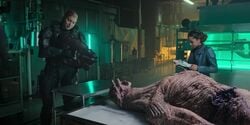
- "See these holes on the top plate? That's where the needle rounds are primed. You pull the trigger and somehow they just know how to target living tissue."
- — Kai-125 explaining her favorite Covenant weapon.[35]
Designated as a "xenotech shard launcher", needlers are used by the Covenant during their war against humanity. They are particularly popular among the Unggoy.[36] Silver Team will occasionally scavenge needlers from dead enemies and use them against Covenant troops.[35]
In-game information[edit]
The needler is a staple across the Halo games, being introduced in Halo: Combat Evolved and appearing in every game ever since. It is a fully-automatic infantry weapon that fires slow-moving needle projectiles that can home in on enemies. In campaign and Firefight, the needler is used by Unggoy, Kig-Yar, Yanme'e, Sangheili, Jiralhanae, and the Flood. In Halo 2, it can be dual wielded, though made impossible to do so in Halo 3. In Halo Infinite, the needler is classified as a submachine gun.
Gallery[edit]

|
Browse more images in this article's gallery page. |
Concept art and illustrations[edit]
Halo Wars concept art featuring Kig-Yar armed with needlers and beam rifles.
An Unggoy Minor takes aim with a needler at Dutch in Halo: Helljumper.
Otto-031 firing a needler at Thon 'Talamee in Halo: Blood Line.
Kig-Yar pirates wielding the needler in Halo: Escalation.
Sali 'Nyon and a Sangheili firing their needlers in Halo: Escalation.
A Kig-Yar firing the needler in Halo: Spartan Assault.
Screenshots[edit]
Captain Jacob Keyes wielding the needler in Halo: Combat Evolved.
A SpecOps Sangheili with the needler in Halo 2.
A Heretic Unggoy wielding the needler in Halo 2.
A Sangheili dual wielding needlers in Halo Online.
Frederic-104 using smart scope on a needler in Halo 5: Guardians.
List of appearances[edit]
Sources[edit]
- ^ Jump up to: a b c d e f g h i j k l m n o p q Halo: The Essential Visual Guide, page 128
- ^ Jump up to: a b c d e f g h i j k Halo 4: The Essential Visual Guide, page 85
- ^ Jump up to: a b c d e f g h i j k l Halo Encyclopedia (2022 edition), page 294
- ^ Jump up to: a b c d e f Halo Encyclopedia (2022 edition), page 479
- ^ Jump up to: a b c d e Halo Waypoint, Canon Fodder - Locke & Load (Retrieved on Aug 2, 2021) [local archive] [external archive]
- ^ Jump up to: a b c d e f g h Bungie.net, Type-33 Guided Munitions Launcher - 9/6/2007 (Retrieved on Jan 16, 2021) [local archive] [external archive]
- ^ Halo: Ghosts of Onyx, chapter 22
- ^ Halo Encyclopedia (2009 edition), page 323
- ^ Jump up to: a b Halo Encyclopedia (2011 edition), page 337
- ^ Halo: Battle for the Blood-Moon
- ^ Halo: Combat Evolved, Needler melee animation
- ^ Halo Infinite, Needler melee animation
- ^ Jump up to: a b c d e f g Halo Waypoint, Universe - Weapons - Needler (Retrieved on Apr 21, 2021) [local archive] [external archive]
- ^ Jump up to: a b c d Twitter, Halo (@Halo): video narration "Mechanically simple and able to inflict gruesome damage with negligible accuracy, the needler was a popular infantry weapon in Covenant service, especially among lower castes. It remains in widespread use among the Covenant's successor states, appealing even to human pirates, as they consider the weapon flashy and intimidating. Moreover, the shard ammunition has little risk of causing dangerous hull perforations, given that the crystal ricochets off most surfaces."
- ^ Jump up to: a b c Halo 5: Guardians, Talon of the Lost REQ card: "Sangheili miners and engineers continue to discover amazing new properties of the Subanese crystals used in Needler ammunition. Advanced Needler that fires carefully calibrated shards that can embed themselves in armor."
- ^ Halo Waypoint, Halo 4 Interactive Guide - Covenant Weapons (Retrieved on Mar 27, 2014) [local archive] [external archive]
- ^ Jump up to: a b c d Halo: Reach, gameplay
- ^ Jump up to: a b c d Halo 4, gameplay
- ^ Halo Encyclopedia (2011 edition), page 237
- ^ Bungie.net, Halo: Reach Ordnance Page (Retrieved on Feb 7, 2021) [archive]
- ^ Jump up to: a b Halo: Reach, Dr. Halsey's personal journal
- ^ Halo Waypoint, Forums - Catalog Interaction (post 2969311) (Retrieved on Oct 14, 2014) [local archive] [external archive]
- ^ Jump up to: a b Halo 5: Guardians, Hailstorm REQ card: "The Hailstorm owes much to a pre-Covenant weapon used during the volatile early-interstellar period of Sangheili history. Improved Needler which fires fast-moving crystal shards that exhibit strong homing behavior."
- ^ Halo Wars, campaign level Relic Interior
- ^ Halo: Combat Evolved, campaign level The Maw
- ^ Halo 3: ODST, gameplay
- ^ Halo Wars, gameplay
- ^ Halo Encyclopedia (2022 edition), page 200
- ^ Halo Encyclopedia (2022 edition), page 301
- ^ Halo: Outpost Discovery: Hall of History - Needler plaque
- ^ Halo 3 marketing, Believe campaign, Enemy Weapon
- ^ Jump up to: a b c d Halo Infinite, gameplay
- ^ Halo Infinite, Forge - Pinpoint Needler description: "Modified Needler with advanced target acquisition and lower supercombine requirement."
- ^ Halo 5: Guardians, gameplay
- ^ Jump up to: a b Halo: The Television Series, episode Homecoming
- ^ Halo: The Television Series marketing, Display at Paramount+ UK launch event
| ||

